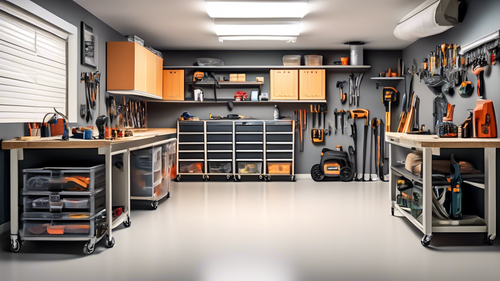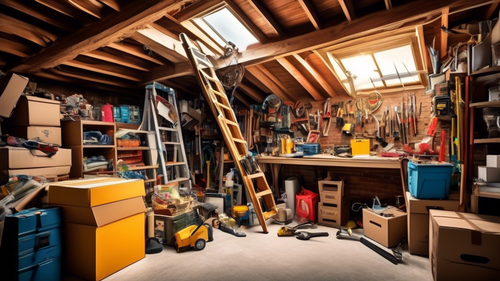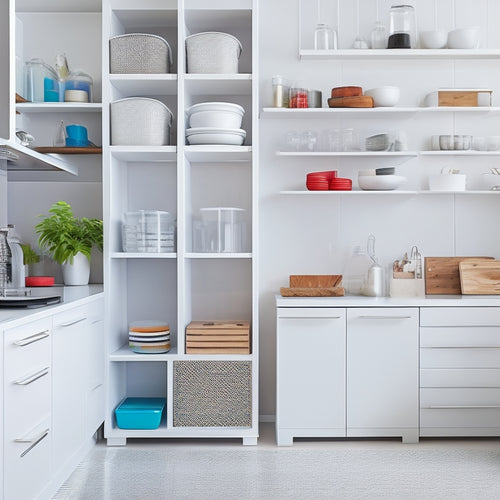
Tame the Clutter: Organize Kitchen Utensils & Cookware
Share
You're ready to tame the clutter in your kitchen! Start by purging unwanted items, being honest about what you use and what you can repurpose or sell. Next, categorize your utensils and cookware into groups, like baking supplies and dinnerware, and assign a home for each item. Utilize vertical storage spaces with shelves, hooks, or pegboards, and maximize your drawers with dividers and adjustable organizers. Implement a "one in, one out" policy to maintain your new space, and designate zones for common tasks like prep, cooking, and storage. Now, take the next step to create a kitchen that works for you.
Key Takeaways
• Separate kitchen items into keep, donate/sell, and discard piles to declutter and make extra cash.
• Categorize utensils and cookware by type, frequency of use, and functionality for easy access and storage.
• Assign a home for each item by labeling containers, utilizing color-coding, and storing items in designated cabinets or drawers.
• Maximize vertical storage spaces with shelves, hooks, or pegboards to free up counter space and optimize corner areas.
• Implement storage solutions like drawer dividers, vertical racks, and hanging hooks to maintain a tidy and organized kitchen.
Purge Unwanted Kitchen Items
Tackle the clutter by pulling everything out of your kitchen cabinets and drawers, and separate items into three piles: keep, donate/sell, and discard, to make sure you're only holding onto utensils and cookware that serve a purpose. This purge is essential to reorganize your kitchen space efficiently.
As you sort, be honest with yourself – when was the last time you used that garlic press or that set of novelty cookie cutters? Be ruthless, and don't let sentimental value get in the way of a clutter-free kitchen.
Place items you no longer need or use into donation bins or set them aside for a garage sale. You can also repurpose items like old jars or containers to store kitchen essentials like spices or utensils. Consider the items you're getting rid of as an opportunity to make some extra cash or declutter someone else's life.
Categorize Utensils and Cookware
Now that you've purged your kitchen of unwanted items, it's time to categorize the utensils and cookware you're left with.
You'll want to group similar utensils together, sort pots and pans by type, and organize cookware into categories that make sense for your cooking style.
Utensil Groupings Matter
As you begin to organize your kitchen utensils and cookware, categorizing them into distinct groups is essential to maximizing storage space and streamlining cooking processes.
You'll want to create functional groupings that make sense for your cooking habits. For instance, group all your baking utensils together, such as whisks, spatulas, and measuring cups. This way, when you're baking a cake, you'll have everything you need within arm's reach.
Another effective approach is color coding. Assign a specific color to each category, like using red for cooking utensils, blue for baking, and green for serving. This visual system will help you quickly identify where each item belongs, making it easier to put things back in their place.
Pots and Pans Sorted
You'll find it's just as crucial to categorize your pots and pans as it's to group your utensils, since they take up a significant amount of storage space and can be heavy to move around.
By doing so, you'll optimize your pantry organization and make the most of your kitchen's hanging storage. Start by grouping similar items together, such as all your frying pans or saucepans.
Then, consider investing in stackable cookware to maximize vertical storage and reduce clutter. Don't forget about pot lid organizers, which can keep your lids tidy and within reach.
When categorizing your pots and pans, think about how often you use each item and prioritize the most frequently used ones. This will guarantee that your go-to cookware is easily accessible and saves you time in the kitchen.
Cookware by Category
Categorize your cookware into groups like baking dishes, skillets, saucepans, and Dutch ovens to ensure easy access and efficient storage. This organized approach will help you locate the right cookware for the job, saving you time and reducing frustration. When categorizing, consider the frequency of use, size, and material of each piece.
Store your most frequently used items in easy-to-reach locations, and reserve harder-to-access areas for less-used items.
Proper cookware maintenance is essential to extend its lifespan. Regular cleaning and care will prevent rust, corrosion, and damage. Research the specific cleaning and care instructions for each material, such as stainless steel, non-stick, or cast iron.
When buying new cookware, consider the quality vs. price ratio. A higher price doesn't always mean better quality. Look for durability, heat distribution, and non-stick performance. Read reviews, consult buying guides, and consider your cooking needs before making a purchase.
Assign a Home for Each Item
Designate a specific spot for each kitchen utensil and cookware item, ensuring everything has a dedicated place to return to after use. This simple habit will revolutionize your kitchen's organization and make cooking a breeze.
Start by categorizing your items into groups, such as baking supplies, cooking utensils, and dinnerware. Next, assign a home for each group, like a specific cabinet or drawer.
Label containers and baskets to identify what's inside, making it easy to find what you need at a glance. For utensils, try color-coding them by type or frequency of use. This visual system will help you quickly identify where things belong, preventing clutter from building up again.
For example, store all your baking utensils in a red basket, and your cooking utensils in a blue one. By assigning a home for each item, you'll maintain a tidy kitchen and save time searching for misplaced items.
Utilize Vertical Storage Spaces
When you're organizing your kitchen, don't forget to look up! You can create a lot of extra storage by utilizing your kitchen's vertical spaces.
Maximize Wall Space
By installing shelves, hooks, or a pegboard on your kitchen walls, you can efficiently store utensils, pots, and pans, freeing up valuable counter and cabinet space. This is an ideal way to maximize wall space, keeping your kitchen organized and clutter-free.
Use wall hooks to hang items like pots, pans, utensils, and even aprons, keeping them within easy reach while saving space. These space-saving hooks can be strategically placed near cooking stations, making it convenient to grab what you need quickly.
In addition to hooks, consider hanging racks that offer decorative functionality. These racks can hold items like plates, glasses, and cookbooks, adding a touch of elegance to your kitchen while keeping essentials organized.
With these storage solutions, you'll be able to maintain a tidy kitchen, focus on cooking, and enjoy the peace of mind that comes with a well-organized space.
Optimize Corner Areas
Now that you've maximized your wall space, turn your attention to the often-wasted areas in the corners of your kitchen, where cleverly designed storage solutions can reveal hidden vertical spaces. Corner solutions can be a game-changer in small kitchens, providing space-saving hacks that keep your countertops clutter-free.
Here are some creative solutions to get you started:
| Corner Solution | Benefits | Estimated Cost |
|---|---|---|
| Carousel Corner Shelf | Easy access to infrequently used items, maximizes corner space | $50-$100 |
| Pull-Out Corner Drawer | Convenient storage for heavy or bulky items, reduces clutter | $100-$200 |
| Magnetic Corner Strip | Holds spices, oils, or utensils, keeps countertops clear | $10-$30 |
Hang Heavy Items
How can you free up valuable floor and counter space by strategically hanging your heaviest kitchen items, like pots, pans, and utensils, to create a more efficient and organized kitchen layout? By utilizing vertical storage spaces, you can maximize your kitchen's potential and make cooking a breeze.
Here are some tips to get you started:
-
Install sturdy hooks for hanging heavy items, such as cast-iron skillets or large utensils, making them easily accessible while keeping them out of the way.
-
Use pot racks for storage of cookware, keeping your pots and pans organized and within reach.
-
Consider hanging a pegboard on a wall or the back of a door, where you can hang baskets, utensils, or even a cookbook.
- Don't forget about the ceiling – hang a pot rack or a utensil holder from the ceiling to make the most of your kitchen's vertical space.
Maximize Drawer Organization Systems
You can greatly enhance the efficiency of your kitchen by tailoring your drawer organization systems to the specific utensils and cookware you use most frequently. By doing so, you'll be able to quickly find what you need, reducing cooking time and stress. To maximize your drawer space, consider using drawer dividers to separate utensils, cookware, and gadgets. This will prevent clutter from building up and make it easier to clean.
| Drawer Organization Solution | Benefits |
| Drawer Dividers | Separates utensils, cookware, and gadgets, preventing clutter |
| Vertical Racks | Maximizes vertical space, keeping frequently used items accessible |
| Hanging Hooks | Utilizes back-of-drawer space, storing items like oven mitts and utensils |
Additionally, hanging hooks and corner shelves can be used to optimize the often-wasted space in the back and corners of your drawers. By implementing these solutions, you'll be able to store more items in a smaller space, keeping your kitchen organized and efficient.
Optimize Countertop Real Estate
Now that you've maximized your drawer organization, it's time to turn your attention to optimizing your countertop real estate.
To do this, you'll need to clear the clutter, designate specific zones for frequently used items, and make the most of vertical storage options.
Declutter Countertop Surfaces
Countertop surfaces often become cluttered with utensils, appliances, and cookware, leaving little room to prepare meals efficiently. To declutter your countertops, you'll need to get intentional about what stays and what goes. Start by asking yourself what you use daily and what can be stored away.
Here are some strategies to help you declutter your countertop surfaces:
-
Utilize hidden storage by installing slide-out drawers, spice racks, or knife blocks under your countertops.
-
Incorporate decorative hooks to hang items like pots, pans, utensils, and even aprons.
-
Designate a specific area for frequently used items, like a coffee station or a breakfast nook.
- Consider investing in multi-functional appliances that can replace multiple items, freeing up valuable counter space.
Assign Zones for Items
By categorizing your kitchen items into zones, you'll be able to optimize your countertop real estate and create a more functional cooking space. This strategy enables you to label zones and organize efficiently, making it easier to find what you need when you need it.
| Zone | Items |
|---|---|
| Cooking Zone | Stovetop, oven, cookbooks, utensils (e.g., whisks, spatulas) |
| Prep Zone | Countertop, cutting boards, knives, peelers, graters |
| Storage Zone | Cabinets, pantry, dry goods (e.g., pasta, rice, canned goods) |
Assigning zones helps you prioritize your kitchen items and allocate space accordingly. For instance, you may want to dedicate a specific area near the stovetop for cooking utensils, while reserving a separate zone for food preparation. By doing so, you'll reduce clutter and create a more streamlined cooking experience. Remember to label each zone clearly, so you and others can easily identify where items belong. With zones in place, you'll be able to organize efficiently, saving time and energy in the long run.
Utilize Vertical Storage
Take advantage of your kitchen's vertical space to maximize storage capacity and free up valuable countertop real estate for food preparation and cooking. By utilizing vertical storage, you'll create a more efficient and organized kitchen that allows you to focus on what matters most - cooking and entertaining.
Here are some ways to optimize your kitchen's vertical space:
-
Install wall hooks to hang frequently used items like pots, pans, utensils, and even aprons, keeping them within easy reach.
-
Use hanging baskets to store snacks, spices, or cleaning supplies, keeping them organized and out of the way.
-
Implement shelf dividers to separate cookbooks, dinnerware, and glassware, ensuring everything has its designated spot.
- Invest in vertical racks for storing plates, bowls, or cups, making the most of your cabinet space.
Implement a "One In, One Out" Policy
To maintain a balanced and functional kitchen, adopt the 'one in, one out' policy, where every new utensil or cookware item you bring in prompts the removal of an old or redundant one. This approach guarantees your kitchen remains clutter-free and organized. By implementing this policy, you'll evaluate the usefulness of each item and prevent overcrowding your kitchen with unnecessary utensils or cookware.
| Benefits | Results |
|---|---|
| Evaluate usefulness | Identify redundant items |
| Limit duplicates | Prevent overwhelm |
| Avoid overcrowding | Maintain a balanced kitchen |
Designate Zones for Common Tasks
Now that you've maintained a balanced kitchen with the 'one in, one out' policy, you can focus on optimizing your workspace by designating zones for common tasks, which helps streamline your cooking and prep processes.
By assigning specific areas for tasks like food preparation, cooking, and storage, you'll boost task efficiency and save time. This workflow optimization will enable you to navigate your kitchen with ease, reducing stress and increasing productivity.
Here are some zones to designate:
-
Prep zone: Designate a countertop or island for food preparation, equipped with essential utensils and appliances like knives, cutting boards, and blenders.
-
Cooking zone: Identify a zone for cooking, featuring your stovetop, oven, and cookware.
-
Storage zone: Allocate a zone for storing ingredients, cookbooks, and cleaning supplies, keeping them organized and within reach.
- Cleaning zone: Designate a zone for cleaning, equipped with cleaning supplies, a sink, and a dishwasher.
Store Heavy Items at the Bottom
By reserving lower shelves and cabinets for heavy pots, pans, and appliances, you'll maintain a safer and more accessible kitchen. This strategic bottom storage guarantees proper weight distribution, reducing the risk of shelves collapsing or cabinets toppling over.
Heavy items, such as Dutch ovens or stand mixers, are better suited for lower shelves, where they can be easily accessed without straining your back. Plus, this placement frees up upper shelves and cabinets for lighter, more frequently used items.
Maintain Your Organized Kitchen
Establishing a routine to regularly tidy up your kitchen and restock your utensils and cookware guarantees your newly organized space remains functional and clutter-free. You've put in the effort to organize your kitchen, now it's time to maintain it.
Set aside some time each week to go through your storage containers and drawer dividers to verify everything is still in its place.
Here are some tips to help you maintain your organized kitchen:
- Implement a labeling system to easily identify what's inside storage containers and on shelves.
- Use color coding to categorize utensils and cookware, making it easier to find what you need.
- Assign a home for each item, so everything has a designated place to return to.
- Schedule a monthly deep clean to tackle any clutter that may have accumulated.
Frequently Asked Questions
Can I Organize My Kitchen Without Buying New Storage Solutions?
You can definitely organize your kitchen without breaking the bank! Repurpose items like mason jars, baskets, and crates to create storage solutions. Get creative with DIY solutions, like upcycling old furniture or using adhesive hooks to maximize space.
How Do I Decide What Kitchen Items to Keep and What to Purge?
When deciding what to keep and purge, you'll adopt a minimalist approach by weighing sentimental items against functional use. Follow decluttering tips: if you haven't used it in a year, it's likely taking up valuable space, so let it go.
Are There Any Eco-Friendly Kitchen Organization Material Options Available?
You can opt for sustainable options like recycled bamboo utensil holders or repurposed mason jars for storage, making environmentally friendly choices that not only organize your kitchen but also reduce your carbon footprint.
Can I Use Baskets or Containers With Lids in My Kitchen Organization?
You can definitely use baskets or containers with lids to organize your kitchen. Opt for utensil caddies and stackable bins that fit your style, and label them for easy access to your cooking essentials.
How Often Should I Clean and Maintain My Kitchen Organization System?
You'll want to clean and maintain your kitchen organization system regularly, ideally every 1-2 weeks, to prevent clutter buildup; establish a routine to wipe down containers, dust shelves, and reorganize items to keep your space functional and efficient.
Related Posts
-

Maximizing Garage Storage
Maximize Your Garage Storage: A Comprehensive Guide Welcome to the ultimate guide to maximizing your garage storag...
-

Garage Attic Storage: What You Need to Know
Garage Attic Storage: Everything You Need to Know As a home improvement enthusiast with a passion for decluttering...
-

Maximizing Kitchen Cabinet Storage With Smart Containers
You're ready to maximize your kitchen cabinet storage with smart containers! Start by choosing durable, versatile con...


